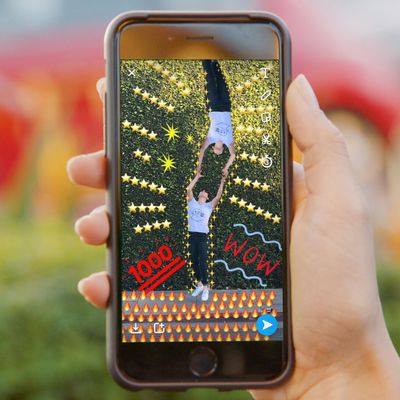
Snapchat videos, unlike those on Vine or Instagram or YouTube, have always stood out for the fact that they feel more — to use a fraught word on the internet — authentic. Less edited, less staged, more I just whipped out my phone and now I’m sending you an eight-second selfie of my face with seven chins. It was fun. It was a little weird. And — despite filters that turned you into a hot puppy or a giant, anthropomorphic taco — sending and receiving snaps felt real, in a way that the more meticulously arranged and curated social networks never really do. (Or, at least, “real.”) But over the past few months, Snapchat has rolled out several new features that seem poised to change all this. As the app has gotten more user-friendly — several new ways to search the previously unsearchable app — it has also become easier for users to curate and modify the content they share.
When Snapchat launched in 2011, Snap Stories — content that lives on the app for 24 hours before vanishing — were but yet a twinkle in Evan Spiegel’s secretly Spectacles-adorned eyes. Instead, it was the app you used to send short-lived photos to your friends and, as alleged by horrified mothers everywhere, to sext. (Moms, if you’re reading this, Snapchat was never really for sexting. Honest.) You’d be mid-commute, open the app, take a selfie grimacing on a stopped train, caption it, “Who is running 15 minutes late?” draw a red arrow to your frowning face and write “this kid” in some crappy cursive, and send it to a half-dozen people. They’d reply with a snap of their own, “same, girl.” Or you’d send a photo of yourself downing a beer to your contacts on a Friday night, and wait and watch as the “reply chug” snaps rolled in. Maybe you’d screenshot a few to mock your friends later. (This was a simpler time before secret screenshotting hacks had been discovered, so at the very least your friend would know you had the picture.) That was Snapchat. And Snapchat was good.
But once the app grew — which, understandably, it had to do to stay competitive — into a place to publicly post longer content for a wider audience, the simple fun that made the app good began to shrink.
Earlier this spring, Snapchat quietly changed the way photos and videos previously taken in the app look when users re-post them. Let’s say you’re at a Chainsmokers concert — I’m so sorry — but cell service is spotty, so you can’t upload your snaps immediately. If you film clips of the concert on your phone’s camera and upload them to your Snapchat Story later, your videos would have a white border around them and a small header reading, “from Camera Roll.” For most of Snapchat’s existence, this was the only way you could snap videos you’d taken in the past, and it meant that videos not taken at that moment, directly for Snapchat, stood out in the app.
Now, if you film the clips via the Snapchat app, save them as Memories, and then upload them to your story, the border vanishes and the small header reads, “from Memories.” It’s a brilliant strategy on Snapchat’s end because the white border is an aesthetic pain. Users get a cleaner-looking story and Snapchat gets people spending more time engaging with the platform. But it also means, for the cursory viewer, that it’s a lot easier to tap through stories and not realize you’re watching old, re-upped content. Snapchatters can more strategically string their stories together and, chances are, many people watching won’t notice the difference.
Today, Snapchat released several other features that let users play with their content before sending and posting. There’s a looping-video tool that feels reminiscent of our dearly departed Vine. (Videos will play ad nauseam until the user either exits the individual snap or taps to the next upload in a Snap Story.) There’s also a magic-eraser tool. Like the app’s sticker tool, the magic eraser lets users crop out objects from their content. Except, unlike the sticker tool, the magic eraser will entirely remove the selected object and fill in the dead space where it used to be. (In theory. We’ll have to see how cleanly this actually works once users get their hands on the tool.) So if you’re standing on a milk crate holding a bunch of red helium balloons in your hand, you can now magically erase the crate out of the photo and it should look like you’re floating.
There’s a great, old (read: 2016) meme that involves poorly editing videos of baseball hits or basketball shots to make each one seem like a home run or a slam dunk: “Haters gonna say it’s fake.” The joke is, apologies in advance as I explain this meme to you, that the feats are indeed fake. Blatantly so. A clip of a 10-year-old girl aiming and shooting at a driveway hoop spliced with a buzzer shot of a March Madness final kind of fake. The videos are funny because you know they’re bogus. Snapchat content was always the opposite of the that; you knew what you were watching hadn’t been — with a few, very obvious, rainbow-vomit-covered exceptions — heavily modified. Few tools for editing and uploading meant Snapchatters were limited to whatever was in front of them at that exact moment. Or behind, if you went the front-facing-camera route. Sure, there were postproduction options — like doodling or emoji or geofilters — but for the most part, it was a lot of organic video clips and intentionally unflattering selfies. And that was good. Now, Snapchat feels dangerously close to becoming a platform full of overedited — think Vine stars backflipping over lanes of moving traffic to “rescue” cats — content. Content haters are gonna say is fake. And the haters will probably be right.





























